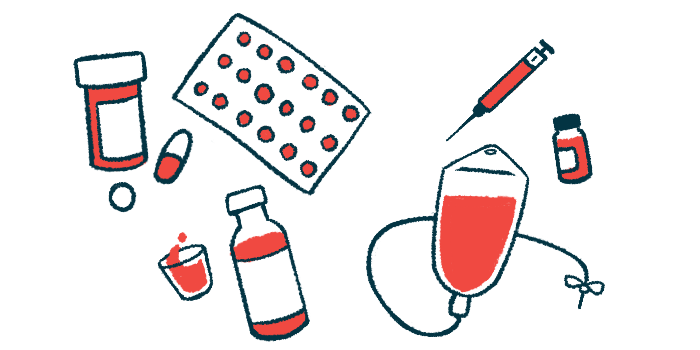Managing multiple medications a burden for many with AAV: Study
Most AAV patients on Medicare take 5 or more medications in 1st year

People with ANCA-associated vasculitis (AAV) often face a high medication burden — managing multiple medications, also known as polypharmacy — with most patients covered by Medicare on five or more treatments at the same time in the first year after their diagnosis, a study found.
Among the factors linked to a greater chance of a high medication burden were a diagnosis of the rarest type of AAV, known as EGPA or eosinophilic granulomatosis with polyangiitis, older age, and the presence of other simultaneous chronic diseases.
Overall, the study found that more than 80% of patients with Medicare insurance took at least five medications during the year following their diagnosis, while more than 40% took 10 or more. Taking multiple medications not only makes managing them harder, but also can lead to drug-drug interactions and a lower adherence to a patient’s treatment plan, the researchers noted.
Given that, newly-diagnosed AAV patients “may benefit from medication therapy management interventions to manage complex drug regimens and reduce risks associated with polypharmacy,” the team wrote.
The study, “Polypharmacy in US Medicare beneficiaries with antineutrophil cytoplasmic antibody vasculitis,” was published in the Journal of Managed Care + Specialty Pharmacy.
Managing multiple medications – 5 or more – known as polypharmacy
AAV is a group of disorders characterized by inflammation and damage to small blood vessels that can affect organ and tissue function. Depending on certain disease features, such as organ involvement, it can be divided into three main types: microscopic polyangiitis (MPA), granulomatosis with polyangiitis (GPA), and EGPA.
While treatment depends on the AAV type, severity, and stage of the disease, it often involves the use of high-dose glucocorticoids, such as prednisone, and non-steroid immunosuppressive medications such as azathioprine and rituximab.
The goal of a patient’s initial treatment is disease remission. After that, “maintenance therapy either using the same therapeutic agent … or switching to a different agent follows to prevent disease relapse,” the researchers wrote.
In addition, other medications may be prescribed to reduce or treat any side effects that occur and to manage organ-specific damage.
This simultaneous use of multiple medications makes polypharmacy — and the need for managing any treatment-related adverse events — commonplace among AAV patients.
Commonly defined as taking five or more medications at the same time, polypharmacy increases costs and makes it hard to keep track of all possible interactions between medications, thereby increasing the risk of side effects. It also can make it hard for patients to stick to their prescriptions as scheduled.
“Although polypharmacy has been studied extensively in [non-AAV] populations, it has not been well-characterized in patients with [AAV],” the researchers wrote.
Data show 41% of AAV patients took 10 or more meds
To address this, a team of researchers in the U.S. drew on 2015-2017 data from Medicare claims to analyze the frequency, characteristics, and risk factors of polypharmacy in the first year after an AAV diagnosis.
Medicare is a U.S. government insurance program for people who are 65 or older that also covers some younger people with disabilities.
Polypharmacy was categorized as absent if a patient took fewer than five medications at the same time, moderate if it involved five to nine medications, and high if the patient used 10 or more medications.
The team identified 1,239 people newly diagnosed with AAV, most of whom (80%) were non-Hispanic white individuals. More than three-quarters (79%) were ages 65 or older and nearly two-thirds (63%) were women. GPA was by far the most common AAV type, seen among 72% of patients, followed by microscopic polyangiitis (17%) and EGPA (11%).
Overall, disease characteristics were similar across the three AAV type groups. The exception was that GPA patients were more likely to have chronic kidney disease and more comorbidities, or simultaneous health conditions, than the other two groups.
In total, 31% of the patients received Medicaid and/or Part D low-income subsidy. Medicaid provides health insurance for adults and children with limited income and resources. Part D low-income subsidy, also called Extra Help, helps people with limited income and resources lower or cut medication costs.
On average, these AAV patients overall were on nine medications at the same time in the first quarter, or three months, after receiving their diagnosis. According to researchers, this indicated that they faced a “high medication burden.”
Moderate or high polypharmacy was most common in the first quarter, with 1,037 patients (84%) taking five or more medications. This percentage — which was greatest for EGPA patients (89%) — generally dropped slightly over time, reaching 79% in the last quarter of the first year after diagnosis.
A total of 502 patients (41%) took at least 10 medications. This percentage also was reduced over time, with one-third of the patients (33%) still being on 10 or more medications in the last quarter of the first year following diagnosis.
This may be “likely in part due to the start of induction treatment,” the researchers wrote. Induction treatment is a first-line therapy whose goal is remission.
The most commonly prescribed medication was prednisone, used by nearly half of patients (46%). Levothyroxine was used to treat an underactive thyroid gland in 23% of patients. Rounding out the top five were amlodipine, used by 24% of patients, metoprolol, taken by 22%, and furosemide, taken by 20% to treat cardiovascular diseases.
“GPA and MPA subtype groups had similar top 10 medications as the entire [patient population],” the researchers wrote, while people with EGPA, who often experience asthma-like symptoms, were frequently prescribed medications to help with breathing.
“Azathioprine, methotrexate, mycophenolate mofetil, and [rituximab] were the most frequently used nonsteroid immunosuppressants across all 4 quarters, although none were among the top 10 medications,” the team wrote.
Interventions may help patients managing multiple medications
When looking for potential risk factors of polypharmacy, the researchers found that being diagnosed with EGPA more than doubled the odds of falling into either the moderate or high categories relative to a GPA diagnosis.
Also, those with comorbidities such as diabetes, obesity, or chronic kidney disease were significantly more likely, by about twofold, to fall into the high polypharmacy category versus minimal or no polypharmacy at least in the first quarter. Similar results were found for patients with five or more comorbidities, for all quarters of the first year of diagnosis.
Special attention should be paid to patients with [AAV] with risk factors for polypharmacy to improve their health outcomes.
Having Medicaid and/or Part D low-income subsidy also were associated with a significantly higher chance of high polypharmacy in the second, third, and fourth quarter of the year.
“Compared with patients aged 75 years or older, those aged 65 to 74 showed significantly lower odds of moderate polypharmacy for [the third quarter],” the team wrote.
These findings highlighted that people diagnosed with EGPA, “older patients and those with other chronic diseases were more likely to take a lot of medications,” they added.
“Special attention should be paid to patients with [AAV] with risk factors for polypharmacy to improve their health outcomes,” the researchers wrote, adding that high-risk patients may benefit from interventions to make it easier for them to follow their treatment plans and avoid risks inherent with managing multiple medications.
“Future research is needed to examine prescribing quality and safety measures in this population and to optimize the design and implementation of medication management interventions,” the team concluded.









